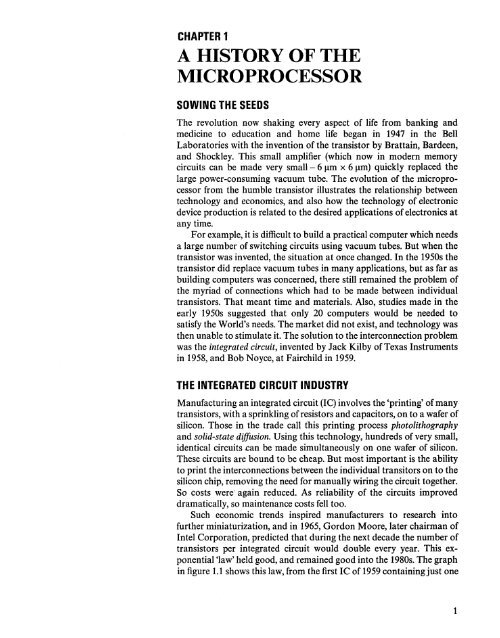Microcomputer Circuits and Processes
Microcomputer Circuits and Processes
Microcomputer Circuits and Processes
You also want an ePaper? Increase the reach of your titles
YUMPU automatically turns print PDFs into web optimized ePapers that Google loves.
CHAPTER 1<br />
A HISTORY OF THE<br />
MICROPROCESSOR<br />
SOWING<br />
THE SEEDS<br />
The revolution now shaking every aspect of life from banking <strong>and</strong><br />
medicine to education <strong>and</strong> home life began in 1947 in the Bell<br />
Laboratories with the invention of the transistor by Brattain, Bardeen,<br />
<strong>and</strong> Shockley. This small amplifier (which now in modern memory<br />
circuits can be made very small- 6 Ilm x 6 Ilm) quickly replaced the<br />
large power-consuming vacuum tube. The evolution of the microprocessor<br />
from the humble transistor illustrates the relationship between<br />
technology <strong>and</strong> economics, <strong>and</strong> also how the technology of electronic<br />
device production is related to the desired applications of electronics at<br />
any time.<br />
For example, it is difficult to build a practical computer which needs<br />
a large number of switching circuits using vacuum tubes. But when the<br />
transistor was invented, the situation at once changed. In the 1950s the<br />
transistor did replace vacuum tubes in many applications, but as far as<br />
building computers was concerned, there still remained the problem of<br />
the myriad of connections which had to be made between individual<br />
transistors. That meant time <strong>and</strong> materials. Also, studies made in the<br />
early 1950s suggested that only 20 computers would be needed to<br />
satisfy the World's needs. The market did not exist, <strong>and</strong> technology was<br />
then unable to stimulate it. The solution to the interconnection problem<br />
was the integrated circuit, invented by Jack Kilby of Texas Instruments<br />
in 1958, <strong>and</strong> Bob Noyce, at Fairchild in 1959.<br />
THE INTEGRATED CIRCUIT INDUSTRY<br />
Manufacturing an integrated circuit (IC) involves the 'printing' of many<br />
transistors, with a sprinkling of resistors <strong>and</strong> capacitors, on to a wafer of<br />
silicon. Those in the trade call this printing process photolithography<br />
<strong>and</strong> solid-state diffusion. Using this technology, hundreds of very small,<br />
identical circuits can be made simultaneously on one wafer of silicon.<br />
These circuits are bound to be cheap. But most important is the ability<br />
to print the interconnections between the individual transitors on to the<br />
silicon chip, removing the need for manually wiring the circuit together.<br />
So costs were"again reduced. As reliability of the circuits improved<br />
dramatically, so maintenance costs fell too.<br />
Such economic trends inspired manufacturers to research into<br />
further miniaturization, <strong>and</strong> in 1965, Gordon Moore, later chairman of<br />
Intel Corporation, predicted that during the next decade the number of<br />
transistors per integrated circuit would double every year. This exponential<br />
'law' held good, <strong>and</strong> remained good into the 1980s.The graph<br />
in figure 1.1shows this law, from the first IC of 1959containing just one<br />
1











